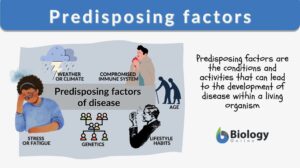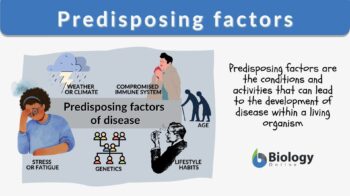
Predisposing factorss
n., plural: predisposing factors
Definition: factor(s) that render(s) an individual vulnerable to a disease or disorder
Table of Contents
All organisms can be born with or develop a disease at any point in their lifetime. When someone is born with a disease, it usually is accompanied by all ailments that come with a disease. When a disease develops during a person’s life, it can appear with no signs, warnings, or symptoms. On the other hand, diseases may have predisposing factors that indicate they might affect an individual soon. But what is a predisposing factor? Let us define predisposing factors below.
Predisposing Factors Definition
Predisposing factors are the risk factors that make a person more susceptible to developing a disease. It should not be confused with precipitating factors. Although they seem the same, they are two different terms. Predisposing factors of the disease are those factors that may lead to disease and precipitating factors are those that create the onset of the disease (or initiate the disease). So predisposing factors can lead to disease but are not guaranteed to do so, whereas precipitating factors will be the beginning of a disease.
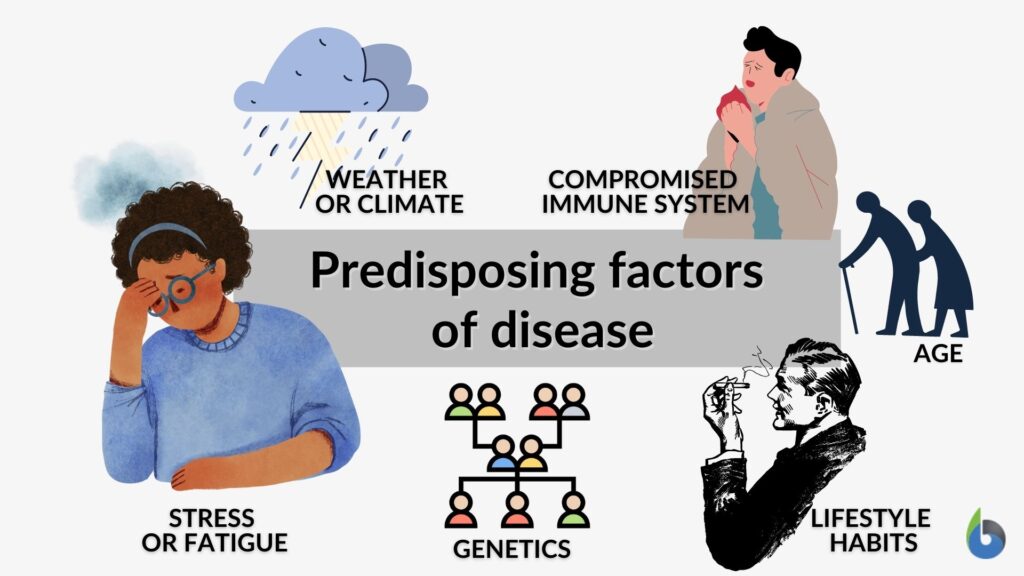
Predisposing factors include predisposing characteristics and predisposing conditions. Predisposing characteristics are those factors that are based on the social and demographic factors of a public that have a major effect on their health, illnesses, and how they will accept treatment. The predisposing conditions are basically the same as the predisposing factors as they are those conditions that give way to the development of disease.
Predisposing factors are factors that can lead to the development of the disease. It is one of the 4Ps of the Biopsychosocial Formulation, which is used for understanding the health condition of an individual. In order to understand the presence of the disease, various factors are looked into, such as predisposing factors, precipitating factors, perpetuating factors, and protective factors. Understanding these aspects enables the medical practitioner in formulating conclusions and hypotheses. READ: 4Ps and the Biopsychosocial Formulation
Predisposing Factors Examples
All diseases that can be developed will consist of predisposing factors that either can cause or will cause the disease eventually. Some predisposing factors for the following diseases will be discussed:
- Cervical Cancer
- Diabetes
- Asthma
Cervical Cancer
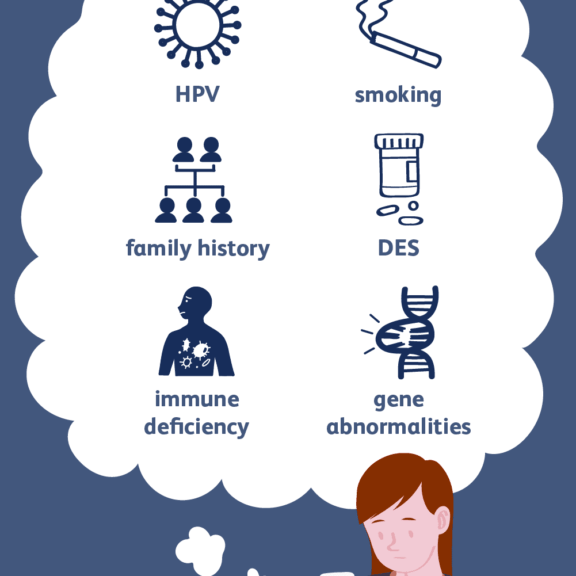
Cervical cancer or cancer of the uterine cervix is a very common illness in women especially those of fertility age. Thousands of women are diagnosed with this disease every year and many out of that group succumb to the symptoms of the disease. There are many known risk factors or predisposing factors that can lead to women developing uterine cancer:
- Human Papillomavirus (HPV) – Human papillomavirus also known as HPV is a sexually transmitted disease that is often related to the development of cervical cancer. However, HPV has been associated with a group of viruses that are carcinogens, and HPV-16, as well as HPV-18, causes the majority of cervical cancer and the lesions that are precancerous too.
- Human immunodeficiency virus (HIV) – the infection better known as HIV has been heavily linked to women having a higher chance of developing cervical cancer. This is because HIV suppresses the immune system of the person, making them more susceptible to harmful diseases such as cancer.
- Smoking – smoking or more specifically tobacco has been linked to the development of cancer of the uterine cervix in women. This has been attributed to the tobacco and tobacco by-products damaging the DNA of the smoker and also suppressing their immune system and immune response. This makes female smokers more susceptible to PHV infections.
- Diethylstilbestrol (DES) – DES was given to women as a medication that was an estrogen form used to treat conditions throughout pregnancy. This was mainly used in the mid-1900s, specifically between 1940 and 1971. Sadly, when the daughters of the women who took DES while pregnant were born, they were found to be at a much greater risk of developing cervical cancer. If these daughters were exposed to HPV, their risk of developing cervical cancer would increase even more.
Diabetes
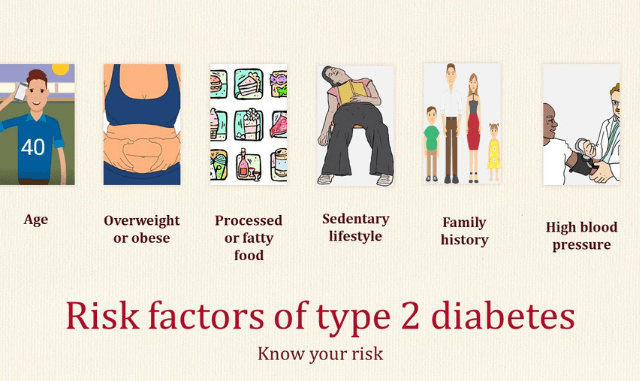
Diabetes is one of the most common, non-communicable diseases that affect the human race. This disease changes the way that your body uses the food you consume and forms energy with it. Usually, the food consumed is digested and turned into sugars that the body will absorb into the bloodstream and use as energy. When there is a saturated amount of sugar in your bloodstream, the body alters the pancreas and it will release insulin. The insulin helps the blood sugar to either be stored in the liver or be used at a greater rate. With diabetics, the body usually has some issue with insulin – whether it does not produce enough or cannot produce at all.
There are three main types of diabetes and they all have different predisposing factors:
- Type 1 Diabetes – This type of diabetes is assumed to be the result of an autoimmune response by the body towards sugar. There are two main predisposing factors of type 1 diabetes:
- Family history – if one or more members of a person’s family have type 1 diabetes, they have a higher risk of developing the disease.
- Age – type 1 diabetes is more likely to develop when a person is a child or teenager versus an adult. However, the disease can be developed at any age.
- Type 2 diabetes – Type 2 diabetes usually comes about as the result of an excess amount of sugars consumed by a person. This results in the pancreas not being able to make enough insulin to manage the sugar levels of the body. There are many predisposing factors of type 2 diabetes:
- Prediabetics – Persons who have been diagnosed to be prediabetic.
- Body size – Persons who are overweight or obese.
- Age – Persons beyond the age of 45 and older. As the body gets older, the organs are less efficient.
- Family history – persons with other close family members who have already been diagnosed with type 2 diabetes such as a sibling or parent.
- Physical activity – the lack of physical activity can increase the risks of developing type 2 diabetes. Persons who are not physically active at least 3 times a week or more likely to develop the disease.
- Gestational diabetes – Women who have been diagnosed with gestational diabetes during any of their pregnancies have a high chance of developing type 2 diabetes. Women whose babies have weighed over 9 pounds are also predisposed to developing type 2 diabetes.
- Race/ethnicity – Persons of African American descent, Hispanic/Latino American ancestry, American Indian descent, Alaska Native, and some Pacific Islanders and Asian American descents are at a greater risk of developing diabetes.
- Gestational diabetes – This type of diabetes is specific to pregnant women who develop diabetic problems during their pregnancy/pregnancies. Some may only have the disease during their time pregnant while others may go on to develop type 2 diabetes after they give birth. Some of the predisposing factors of gestational diabetes are:
- Previous gestational diabetes – pregnant women who have been previously diagnosed with gestational diabetes in pregnancy before.
- Baby size – Pregnant women who have previously given birth to a baby or babies that are over 9 pounds in weight.
- Body size – Pregnant women who are overweight or obese.
- Age – Pregnant women who are over the age of 25 are more susceptible to developing gestational diabetes
- Family history – persons with other close family members who have already been diagnosed with type 2 diabetes such as a sibling or parent.
- PCOS – Pregnant women who have been previously diagnosed with polycystic ovary syndrome (PCOS), a hormonal disorder.
- Race/ethnicity – Persons of African American descent, Hispanic/Latino American ancestry, American Indian descent, Alaska Native, and some Pacific Islanders and Asian American descents are at a greater risk of developing diabetes.
Asthma
Asthmatics or persons with asthma have a chronic lung disease that affects their ability to breathe. This is usually caused by the inflammation of the lungs, bronchus, and other passages of the respiratory system. There are many predisposing factors that can lead to asthma:
- Family history – other immediate family members having asthma puts someone at a much greater risk of developing the lung disease.
- Viral Respiratory infections (VRI) – persons who contracted or had VRIs during their childhood are more susceptible to developing asthma as these can cause wheezing.
- Allergies – allergic conditions are major predisposing factors that lead to asthma. These can be conditions like eczema or hay fever.
- Workplace exposures – Certain occupational hazards can often be the cause of the development of asthma in adults. These may be items like (and are not limited to) chemical fumes/vapors, molds, and dust.
- Smoking – Smokers and persons exposed to second-hand smoke are at a greater risk of developing asthma as cigarette smoke causes the irritation of airways.
Watch another example here: risk factors for depression.
Try to answer the quiz below to check what you have learned so far about predisposing factors.
References
- Predisposing Factors/Risk Factors. (n.d.). Retrieved December 26, 2021, from http://www.bccancer.bc.ca/books/uterine-cervix/predisposing-factors-risk-factors
- CDC. (2021, April 23). Diabetes Risk Factors. Centers for Disease Control and Prevention. https://www.cdc.gov/diabetes/basics/risk-factors.html
- Lilienthal, K., Possemato, K., Funderburk, J., Wade, M., Eaker, A., & Beehler, G. P. (2017). Predisposing Characteristics, Enabling Factors, and Need as Predictors of Integrated Behavioral Health Utilization. The Journal of Behavioral Health Services & Research, 44(2), 263–273. https://doi.org/10.1007/s11414-016-9496-9
- Lung Cancer Risk Factors | Smoking & Lung Cancer. (n.d.). Retrieved December 26, 2021, from https://www.cancer.org/cancer/lung-cancer/causes-risks-prevention/risk-factors.html
- Precipitating factors. (2019, October 7). Biology Articles, Tutorials & Dictionary Online. https://www.biologyonline.com/dictionary/precipitating-factors
©BiologyOnline.com. Content provided and moderated by Biology Online Editors.

